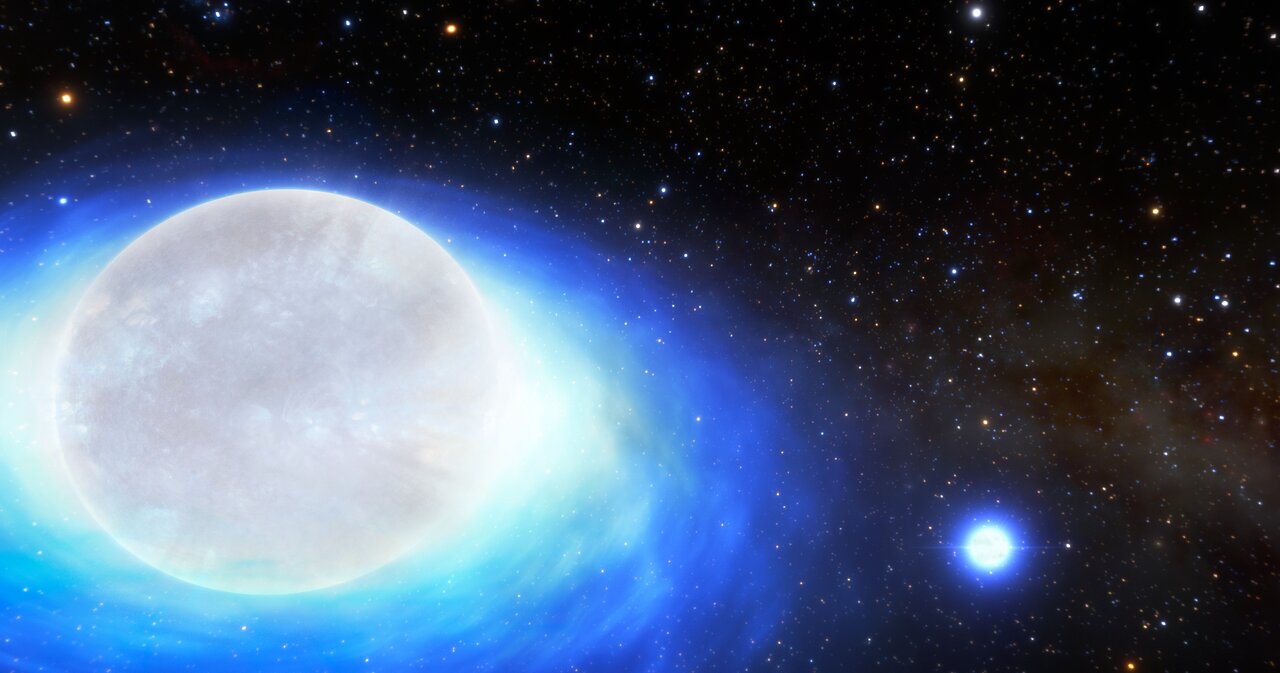Astronomers recently discovered a pair of stars circling each other (a binary star) that will eventually end its life in an explosion so powerful it creates gold. These explosions create large amounts of gold and other heavy metals but their formation has proven difficult to model. This discovery shows how double-stars hold the key for understanding how precious metals are made in the cosmos.
Views 1663
Reading time 3.5 min
published on Oct 25, 2023
In 2017, a cosmic event occurred that changed our understanding of the universe when the Laser Interferometer Gravitational-Wave Observatory (LIGO) detected a merger event from two neutron stars caught in a tight orbit in an event dubbed GW 170817. Neutron stars are stars so dense that a teaspoonful would weigh a billion tons on Earth. Astronomers worked to quickly find a visible counterpart in the galaxy NGC 4993. The merger event triggered a fast production of heavy elements such as gold and platinum in vast abundance. This analysis also showed that such events could provide most of these elements in the Universe.
But, there is at least one lingering question from GW 170817 - how does the binary neutron star system form? Neutron stars form when a massive star dies in a spectacular explosion called a supernova, a massive explosion that occurs when a star dies. This explosion often gives a kick to the binary in some way – either sending the stars in opposite directions and breaking apart the binary or by making the system’s orbit elliptical rather than circular.
The answer to this formation conundrum may be to study systems that have a neutron star and another massive star, these systems are called high-mass X-ray binaries. These systems are pairs of massive stars that emit powerful X-rays when material falls onto a neutron star or black hole. These systems have a massive star with the neutron star orbiting, usually in an elliptical orbit. One recently characterized system seems unique amongst these systems: CPD -29 2176. This binary has an orbit that takes about two months to complete and unlike many other high-mass binaries, the orbit is very circular.
This binary was measured to be circular using spectroscopy taken with a NOIR Lab telescope in Chile that has a 1.5-m diameter mirror. Spectroscopy is a technique that allows scientists to determine the composition and motion of stars by analyzing their light. These spectra showed that the B-type star in the binary has a hydrogen and helium disk surrounding it, typical of a type of star called a B‘e’ star.
The disk around a B‘e’ star is sometimes called a decretion disk – meaning it acts opposite of the normal accretion disks mentioned in astronomy. Accretion disks are rings of dust and/or gas that circle around stars, eventually falling onto their surface. In the case of CPD -29 2176, the star is rotating at a near critical rate which causes the material around its equator to be ejected into a disk. Then the major question becomes how the system got into this configuration, which was a topic in the recent paper by Richardson et al.
In the paper, the system’s history was modeled using a code called BPASS. This code is able to look at binary configurations and compare them to a large grid of models with binary interactions determined. The results are shown in the infographic here. The system, as depicted in (1) started with a primary star weighing 12 suns and a second star weighing about 9 suns. As the main star ran out of hydrogen in its core, it began to change and was near the biggest size it could be in a binary based on tidal forces, a limit called a Roche limit (2). At this time, it began sending material onto the second star (3).
The material overflowed onto the secondary star twice before the initial primary star exploded as a supernova (4). However, the interactions at this point had stripped almost all the outer material off of the original star, leaving very little material left to eject during a supernova explosion. As a result, the system couldn’t become elliptical like many systems with a supernova.
Today the system exists as a B‘e’ star with a neutron star orbiting it in a circular orbit (5). Eventually, this star will evolve and then explode as a supernova (6). But before this, the B‘e’ star will fill its Roche limit and send material towards the neutron star. This interaction will strip the B‘e’ star of most of its hydrogen and helium outer layers, and then we will have very little material for during its explosion so that the neutron stars remain bound in an orbit (7).
With two compact objects like neutron stars (or black holes) in an orbit, they will slowly spiral in towards each other as a result of Einstein’s General Theory of Relativity, the best theory that describes how gravity works. This will make the binary get closer and closer (8), until they eventually merge in a kilonova explosion like GW 170817 (9).
With these new observations and models, astronomers have now found a way with which to explain the production of very heavy elements like gold. Such systems tell us the details of how these systems evolve and eventually merge, even if astronomers only expect 10 such systems in the same phase of evolution in the Milky Way Galaxy. This groundbreaking discovery not only helps us understand how gold is created in the cosmos, but also gives us a glimpse into the life and death of stars as they live their lives and death throes in double systems.
Original Article:
Richardson, N. D., Pavao, C. M., Eldridge, J. J., et al. A high-mass X-ray binary descended from an ultra-stripped supernova. Nature 614, 45–47 (2023)
 Maths, Physics & Chemistry
Maths, Physics & Chemistry



